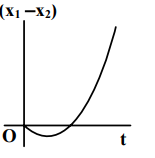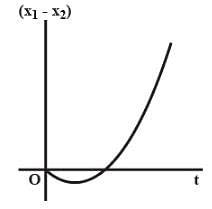Class 11 Exam > Class 11 Questions > A body is at rest at x = 0. At t = 0, it star...
Start Learning for Free
A body is at rest at x = 0. At t = 0, it starts moving in the positive x-direction with a constant accleration. At the same instant another body passes through x = 0 moving in the positive x- direction with a constant speed. The position of the first body is given by x1 (t) after time t and that of the second body by x2(t) after the same time interval.Which of the following graphs correctly describes (x1 – x2) as a function of time? [AIEEE 2008]
- a)
- b)
- c)
- d)
Correct answer is option 'B'. Can you explain this answer?
| FREE This question is part of | Download PDF Attempt this Test |
Verified Answer
A body is at rest at x = 0. At t = 0, it starts moving in the positive...


Most Upvoted Answer
A body is at rest at x = 0. At t = 0, it starts moving in the positive...

► x1(t) = 1/2 at2
► x2(t) = vt
► (x1 - x2) = 1/2 at2 − vt
Now Plot (x1−x2) vs t
Attention Class 11 Students!
To make sure you are not studying endlessly, EduRev has designed Class 11 study material, with Structured Courses, Videos, & Test Series. Plus get personalized analysis, doubt solving and improvement plans to achieve a great score in Class 11.

|
Explore Courses for Class 11 exam
|

|
A body is at rest at x = 0. At t = 0, it starts moving in the positive x-direction with a constant accleration. At the same instant another body passes through x = 0 moving in the positive x- direction with a constant speed. The position of the first body is given by x1(t) after time t and that of the second body by x2(t) after the same time interval.Which of the following graphs correctly describes (x1–x2) as a function of time? [AIEEE 2008]a)b)c)d)Correct answer is option 'B'. Can you explain this answer?
Question Description
A body is at rest at x = 0. At t = 0, it starts moving in the positive x-direction with a constant accleration. At the same instant another body passes through x = 0 moving in the positive x- direction with a constant speed. The position of the first body is given by x1(t) after time t and that of the second body by x2(t) after the same time interval.Which of the following graphs correctly describes (x1–x2) as a function of time? [AIEEE 2008]a)b)c)d)Correct answer is option 'B'. Can you explain this answer? for Class 11 2024 is part of Class 11 preparation. The Question and answers have been prepared according to the Class 11 exam syllabus. Information about A body is at rest at x = 0. At t = 0, it starts moving in the positive x-direction with a constant accleration. At the same instant another body passes through x = 0 moving in the positive x- direction with a constant speed. The position of the first body is given by x1(t) after time t and that of the second body by x2(t) after the same time interval.Which of the following graphs correctly describes (x1–x2) as a function of time? [AIEEE 2008]a)b)c)d)Correct answer is option 'B'. Can you explain this answer? covers all topics & solutions for Class 11 2024 Exam. Find important definitions, questions, meanings, examples, exercises and tests below for A body is at rest at x = 0. At t = 0, it starts moving in the positive x-direction with a constant accleration. At the same instant another body passes through x = 0 moving in the positive x- direction with a constant speed. The position of the first body is given by x1(t) after time t and that of the second body by x2(t) after the same time interval.Which of the following graphs correctly describes (x1–x2) as a function of time? [AIEEE 2008]a)b)c)d)Correct answer is option 'B'. Can you explain this answer?.
A body is at rest at x = 0. At t = 0, it starts moving in the positive x-direction with a constant accleration. At the same instant another body passes through x = 0 moving in the positive x- direction with a constant speed. The position of the first body is given by x1(t) after time t and that of the second body by x2(t) after the same time interval.Which of the following graphs correctly describes (x1–x2) as a function of time? [AIEEE 2008]a)b)c)d)Correct answer is option 'B'. Can you explain this answer? for Class 11 2024 is part of Class 11 preparation. The Question and answers have been prepared according to the Class 11 exam syllabus. Information about A body is at rest at x = 0. At t = 0, it starts moving in the positive x-direction with a constant accleration. At the same instant another body passes through x = 0 moving in the positive x- direction with a constant speed. The position of the first body is given by x1(t) after time t and that of the second body by x2(t) after the same time interval.Which of the following graphs correctly describes (x1–x2) as a function of time? [AIEEE 2008]a)b)c)d)Correct answer is option 'B'. Can you explain this answer? covers all topics & solutions for Class 11 2024 Exam. Find important definitions, questions, meanings, examples, exercises and tests below for A body is at rest at x = 0. At t = 0, it starts moving in the positive x-direction with a constant accleration. At the same instant another body passes through x = 0 moving in the positive x- direction with a constant speed. The position of the first body is given by x1(t) after time t and that of the second body by x2(t) after the same time interval.Which of the following graphs correctly describes (x1–x2) as a function of time? [AIEEE 2008]a)b)c)d)Correct answer is option 'B'. Can you explain this answer?.
Solutions for A body is at rest at x = 0. At t = 0, it starts moving in the positive x-direction with a constant accleration. At the same instant another body passes through x = 0 moving in the positive x- direction with a constant speed. The position of the first body is given by x1(t) after time t and that of the second body by x2(t) after the same time interval.Which of the following graphs correctly describes (x1–x2) as a function of time? [AIEEE 2008]a)b)c)d)Correct answer is option 'B'. Can you explain this answer? in English & in Hindi are available as part of our courses for Class 11.
Download more important topics, notes, lectures and mock test series for Class 11 Exam by signing up for free.
Here you can find the meaning of A body is at rest at x = 0. At t = 0, it starts moving in the positive x-direction with a constant accleration. At the same instant another body passes through x = 0 moving in the positive x- direction with a constant speed. The position of the first body is given by x1(t) after time t and that of the second body by x2(t) after the same time interval.Which of the following graphs correctly describes (x1–x2) as a function of time? [AIEEE 2008]a)b)c)d)Correct answer is option 'B'. Can you explain this answer? defined & explained in the simplest way possible. Besides giving the explanation of
A body is at rest at x = 0. At t = 0, it starts moving in the positive x-direction with a constant accleration. At the same instant another body passes through x = 0 moving in the positive x- direction with a constant speed. The position of the first body is given by x1(t) after time t and that of the second body by x2(t) after the same time interval.Which of the following graphs correctly describes (x1–x2) as a function of time? [AIEEE 2008]a)b)c)d)Correct answer is option 'B'. Can you explain this answer?, a detailed solution for A body is at rest at x = 0. At t = 0, it starts moving in the positive x-direction with a constant accleration. At the same instant another body passes through x = 0 moving in the positive x- direction with a constant speed. The position of the first body is given by x1(t) after time t and that of the second body by x2(t) after the same time interval.Which of the following graphs correctly describes (x1–x2) as a function of time? [AIEEE 2008]a)b)c)d)Correct answer is option 'B'. Can you explain this answer? has been provided alongside types of A body is at rest at x = 0. At t = 0, it starts moving in the positive x-direction with a constant accleration. At the same instant another body passes through x = 0 moving in the positive x- direction with a constant speed. The position of the first body is given by x1(t) after time t and that of the second body by x2(t) after the same time interval.Which of the following graphs correctly describes (x1–x2) as a function of time? [AIEEE 2008]a)b)c)d)Correct answer is option 'B'. Can you explain this answer? theory, EduRev gives you an
ample number of questions to practice A body is at rest at x = 0. At t = 0, it starts moving in the positive x-direction with a constant accleration. At the same instant another body passes through x = 0 moving in the positive x- direction with a constant speed. The position of the first body is given by x1(t) after time t and that of the second body by x2(t) after the same time interval.Which of the following graphs correctly describes (x1–x2) as a function of time? [AIEEE 2008]a)b)c)d)Correct answer is option 'B'. Can you explain this answer? tests, examples and also practice Class 11 tests.

|
Explore Courses for Class 11 exam
|

|
Suggested Free Tests
Signup for Free!
Signup to see your scores go up within 7 days! Learn & Practice with 1000+ FREE Notes, Videos & Tests.






















